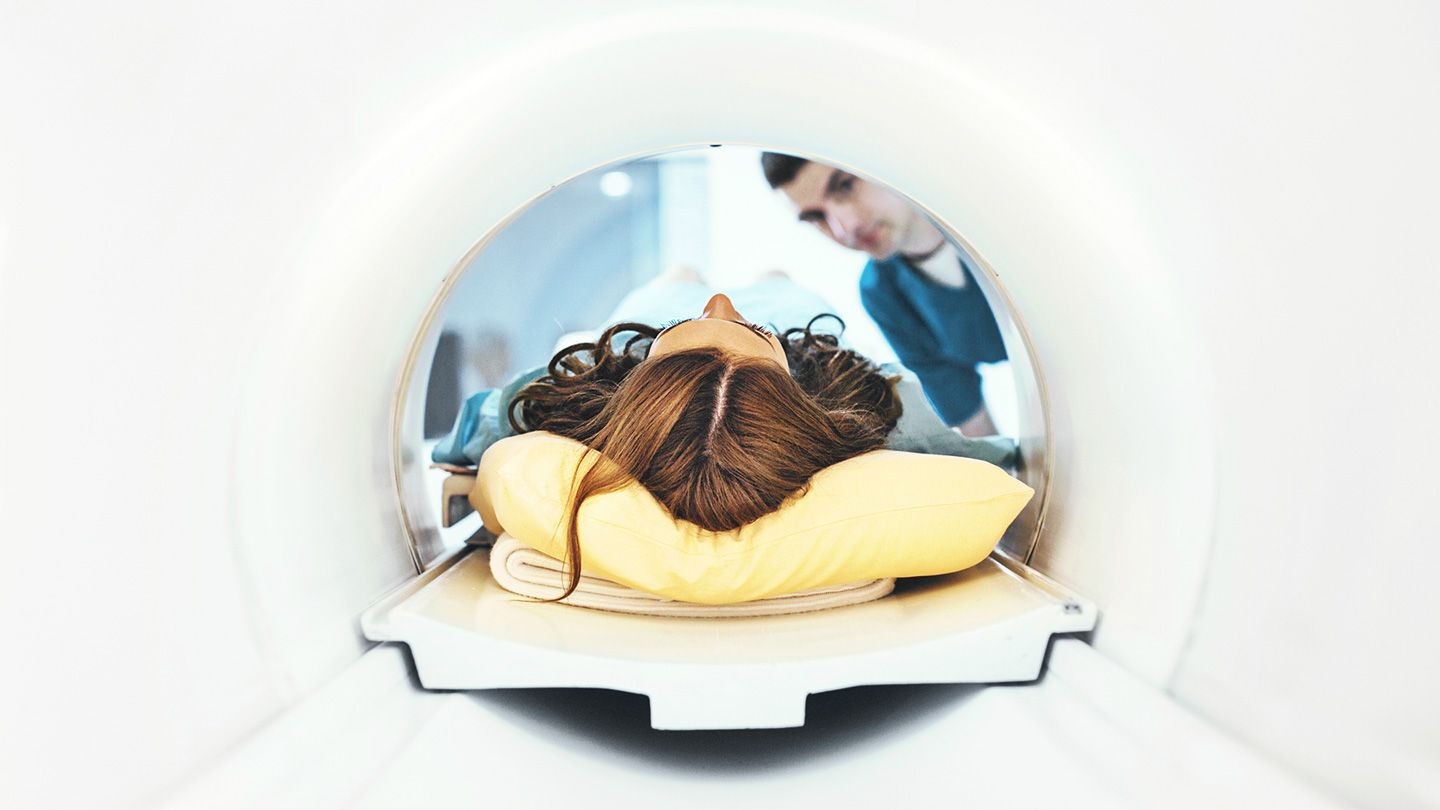Magnetic resonance imaging, or MRI, is a noninvasive medical imaging technique that helps doctors diagnose and monitor various health conditions. While some other imaging techniques, such as CT scans and X-rays, produce images by exposing you to ionizing radiation, an MRI creates detailed, high-resolution images of organs, tissues, and other structures inside your body using powerful magnets and radio waves. When performed according to safety guidelines, MRI are safe and painless and pose almost no risk to the average person.e60dc2a1-f33c-4a05-9b50-8e3e8e597629a59371aa-4e3c-412d-835d-80bcccc255c1e60dc2a1-f33c-4a05-9b50-8e3e8e597629b85121f8-f460-4204-a32a-93fac96ee645
Types Types Types of MRI Machines When you think about MRI, the traditional MRI machine — a narrow metal tube with a bed that slides in — is probably what comes to mind. But there are actually several types of MRI machines, including:e60dc2a1-f33c-4a05-9b50-8e3e8e5976295a9211d1-8d10-4ca7-bb7f-af7ab9f29af2 Wide-bore MRI, which is a slightly wider version of the traditional machine, making it more suitable for larger bodies or those with claustrophobia High-field open MRI, which resembles hamburger buns rather than the traditional MRI machine’s “pig in a blanket” design, allowing the patient more visibility and movement Open upright MRI, in which you can stand or sit between the machine’s two parts (best for people who have trouble lying down or staying still for a long time) MRI machines also differ in how strong their magnets are, which affects the resolution of the images they produce, with 3 Tesla (3T) MRI being more powerful than 1.5T.e60dc2a1-f33c-4a05-9b50-8e3e8e597629b1ab98df-2d06-4a15-b4db-50789a2cda2f Some larger academic medical centers are now using 7T MRI; 7T MRI features more than twice the magnetic field strength of a 3T machine.e60dc2a1-f33c-4a05-9b50-8e3e8e597629e132103f-1107-4020-904c-538a79e82439 Types of MRI Scans Healthcare providers can use MRI to evaluate any part of the body, and the technology is especially suited for imaging the soft tissues like the brain, spinal cord, muscles, and tendons.e60dc2a1-f33c-4a05-9b50-8e3e8e597629288b2e85-0093-4d64-a1d8-5c0d2abbf16f Some common specific or specialized types of MRI include: Functional MRI (fMRI) Measures and maps brain activity by detecting changes in blood flow Diffusion MRI (dMRI) and Diffusion Tensor Imaging (DTI) Measures the movement of water molecules within tissues and is especially useful for imaging white matter tracts in the braine60dc2a1-f33c-4a05-9b50-8e3e8e5976296782c1e9-41a3-4173-a17f-44caeecc4144 Breast MRI Provides detailed images of breast tissue to detect and evaluate breast diseases and reveal abnormalities other imaging techniques cannot (though it doesn’t replace, and is often used along with, mammography and ultrasound) Cardiac (or cardiovascular) MRI Images the heart, valves, and blood vessels to detect abnormalities and assess how well your heart is functioning Magnetic Resonance Angiography (MRA) Focuses on blood vessels and helps identify issues like aneurysms or blockages Magnetic Resonance Enterography Images the intestines to diagnose and monitor issues like inflammatory bowel disease (IBD) Some MRI techniques require special contrast agents or dyes given through an IV — these dyes, which typically contain the element gadolinium, improve the quality of images, providing better visualization of blood vessels and blood flow.e60dc2a1-f33c-4a05-9b50-8e3e8e597629214c5295-6bae-4d3c-b716-c9aca9c11225
Why Is MRI Performed? Why It’s Done MRI is incredibly versatile and used to investigate, diagnose, or monitor a wide range of medical issues throughout the body, such as: Neurological issues including brain tumors, conditions affecting the eyes or ears, multiple sclerosis, stroke, and spinal cord injuries Musculoskeletal issues including torn ligaments, cartilage damage, herniated discs, bone infections, and joint disease Cardiovascular abnormalities including narrowed or blocked blood vessels, thickened heart walls, and heart attack impactse60dc2a1-f33c-4a05-9b50-8e3e8e59762907b88f20-17ef-4299-b4e0-d94a3d12aa38 Gastrointestinal diseases including IBD and bowel tumorse60dc2a1-f33c-4a05-9b50-8e3e8e597629ffc14729-ee97-4404-9868-a7b5f42e30ad Tumors and other irregularities of other organs, including the liver, kidneys, uterus, and prostate
How Is MRI Performed? How It’s Performed MRI scans work by combining strong magnetic fields and radio waves. When subjected to the MRI’s powerful magnetic field, the protons in your body’s molecules align in the same direction like tiny magnets. When hit with bursts of radio waves from the machine, these protons fall out of alignment; they line back up when the radio waves are turned off, releasing radio waves in the process that the MRI analyzes. The time it takes for the protons to realign with the magnetic field, and the radio wave energy they release, varies between specific molecules or tissues in your body, allowing the MRI to produce detailed images that distinguish between various types of body tissue.e60dc2a1-f33c-4a05-9b50-8e3e8e59762961aa3c2a-75f1-4340-a9ea-ffff9a33cf67 This whole procedure is painless and takes up to 60 minutes while you lie down, sit, or stand in the machine (depending on the MRI used). Technicians will help position you correctly in the machine and then go into an adjacent room to operate the machine, communicating with you through a two-way intercom.e60dc2a1-f33c-4a05-9b50-8e3e8e59762909d13e37-25ad-4649-9571-836a7f969afb
How Do I Prepare for an MRI? How to Prepare Preparation for an MRI is generally simple, but it’s important. When setting up your appointment, let your provider know if you: Have claustrophobia Are unable to lie still on your back for up to 60 minutese60dc2a1-f33c-4a05-9b50-8e3e8e597629b2234c75-38a3-42e7-b39e-114c4afc0190 Are pregnant Have allergiese60dc2a1-f33c-4a05-9b50-8e3e8e5976290ec67ce8-e96a-45c8-a53f-46ea9f4def4e Have severe kidney failure and require dialysis, which carries risk of a serious illness if you receive a gadolinium contraste60dc2a1-f33c-4a05-9b50-8e3e8e597629903181c2-8d52-4e99-8144-a8ce28c040b6 Given the strong magnetic fields the MRI produces, let your MRI technician know if you have any type of metal in your skin or body, such as:e60dc2a1-f33c-4a05-9b50-8e3e8e597629019bfd62-9280-45aa-9d16-0660f044ff2a Heart pacemaker or defibrillator Implanted stimulators or devices, including deep brain stimulators, vagus nerve stimulators, and implanted electrodes or wires Metallic protheses Cochlear or ear implants Stents Insulin pumps Metallic shrapnel Body piercings On the day of your appointment, make sure not to wear jewelry or clothing that has metal in it like zippers or underwire bras (though you’ll likely be given a hospital gown to wear). You may also be asked to avoid eating or drinking within four to six hours of your scan.e60dc2a1-f33c-4a05-9b50-8e3e8e59762982977a20-75f5-4daa-8463-5b0122cb5d1a
What Should I Expect During an MRI? What to Expect An MRI is painless, but it can be a strange experience. Expect: Loud thumping and humming noises from the MRI machine (you’ll be given earplugs or headphones to reduce the noise) Remaining still for up to an hour or more Cold from the scanning bed and air-conditioned room (you should be able to request a blanket) Mild warmth in the area of the body being scannede60dc2a1-f33c-4a05-9b50-8e3e8e5976297de990d7-74a1-4932-aad2-9f800df9d777 Communicating with the technologist through an intercom system and having a call button to use if you have any problems or concerns An IV line if you are receiving a contrast agent
What Are the Potential Risks Associated With MRI? Risks MRI is generally considered safe because it does not use ionizing radiation. But there are some potential risks and considerations.e60dc2a1-f33c-4a05-9b50-8e3e8e59762921d41bcb-b3b5-41fe-aed1-9c6841235557 Injury from small projectile metals if they are not removed from the room when the MRI is activated Burns from transdermal patches like nicotine patches if not removed Burns from tattoos, permanent cosmetic products, and synthetic clothing that contain metallic components Psychological distress from being in a confined space for a prolonged time Hearing damage if earplugs or headset are not used properly
What Type of Care Is Needed After an MRI? Follow-Up Care No special care is typically required after an MRI scan. If you received a sedative during the procedure, you will need someone to drive you home (this should be arranged before the appointment).e60dc2a1-f33c-4a05-9b50-8e3e8e5976297c55a5d0-30e3-4a03-8be4-9718b1c62eca
What Are the Possible Complications and Side Effects of MRI? Complications Though rare, side effects and complications of MRI include: Nephrogenic systemic fibrosis, a rare but serious condition linked to gadolinium contrast in people with severe kidney dysfunction Allergic reaction to the contrast, which may cause a rash, nausea, headache, and pain at the injection sitee60dc2a1-f33c-4a05-9b50-8e3e8e597629f4a17318-bffd-4ae7-b482-5a0550a54f7e Headache, fatigue, irritability, and high blood pressure from the strong magnetic fielde60dc2a1-f33c-4a05-9b50-8e3e8e59762904b6ad7c-e467-4b8b-a351-1c0416877935 Temporary hearing loss or tinnitus (ringing in the ears)e60dc2a1-f33c-4a05-9b50-8e3e8e597629748a8623-e5ce-4c00-9e0a-c4e1e4d963bf Anxiety
What’s Next What’s Next? After your MRI, a radiologist will analyze the images and send a report to your referring physician. Expect your results within a week. Your provider will review the findings with you and discuss next steps — whether that’s a treatment plan, further testing, or simply ruling out certain potential conditions explaining your ailments.e60dc2a1-f33c-4a05-9b50-8e3e8e597629f6d37413-8e0a-4fbb-8a4f-e005671d8be5
The Takeaway An MRI is a safe, noninvasive imaging test that uses magnetic fields and radio waves to create detailed pictures of the body’s internal structures. It is used to diagnose and monitor a wide range of health issues throughout the body, including stroke, soft tissue damage, narrowed or blocked blood vessels, and tumors. The procedure typically takes less than an hour and may require you to lie still inside a cylindrical machine that can feel noisy and confined (other, more open MRI machines may be available). Side effects and complications are rare, and the test requires no follow-up care.
Read the full article here
Leave a comment




